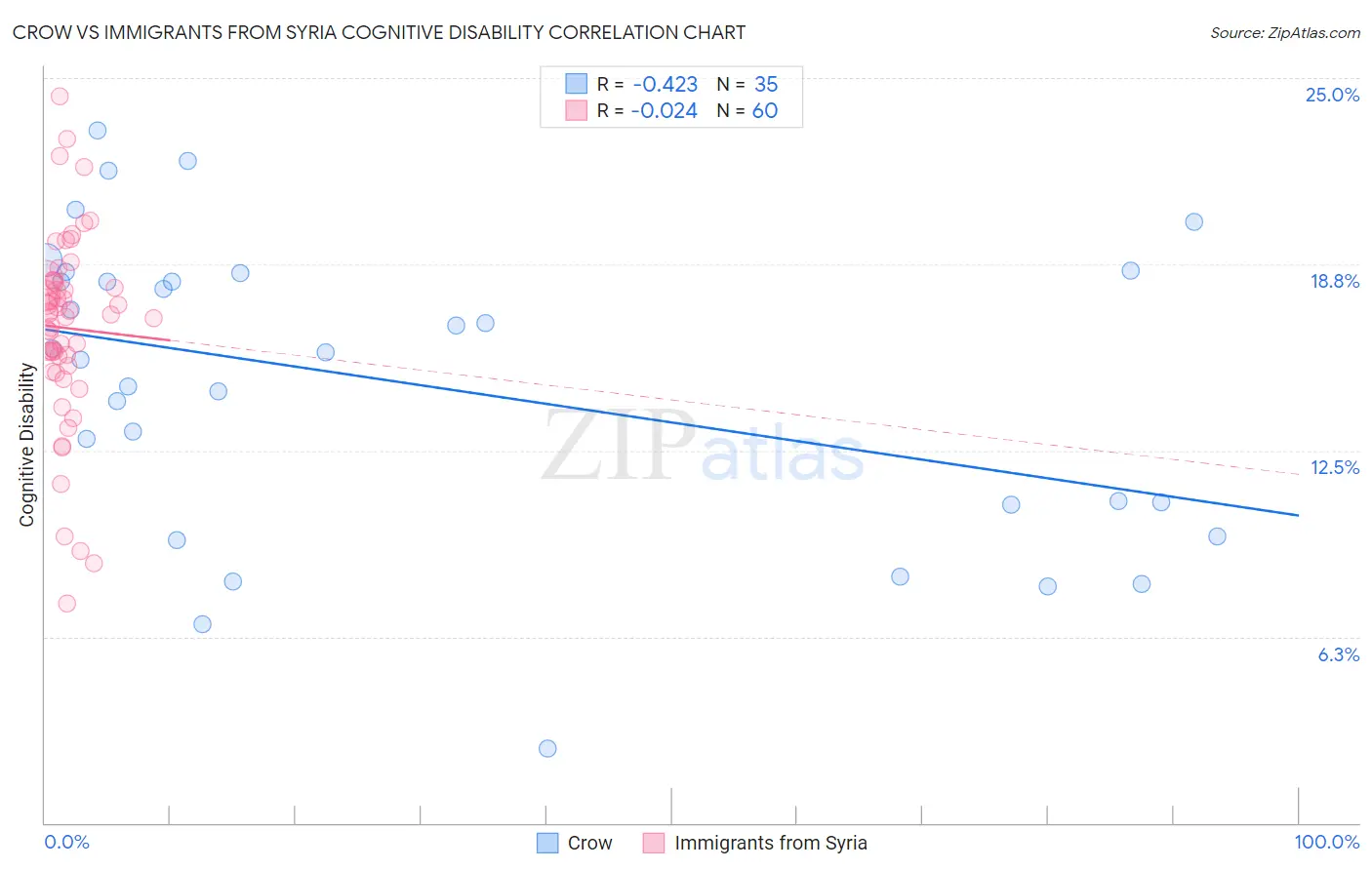Crow vs Immigrants from Syria Cognitive Disability
COMPARE
Crow
Immigrants from Syria
Cognitive Disability
Cognitive Disability Comparison
Crow
Immigrants from Syria
17.3%
COGNITIVE DISABILITY
39.1/ 100
METRIC RATING
184th/ 347
METRIC RANK
17.2%
COGNITIVE DISABILITY
63.5/ 100
METRIC RATING
167th/ 347
METRIC RANK
Crow vs Immigrants from Syria Cognitive Disability Correlation Chart
The statistical analysis conducted on geographies consisting of 59,204,553 people shows a moderate negative correlation between the proportion of Crow and percentage of population with cognitive disability in the United States with a correlation coefficient (R) of -0.423 and weighted average of 17.3%. Similarly, the statistical analysis conducted on geographies consisting of 174,112,347 people shows no correlation between the proportion of Immigrants from Syria and percentage of population with cognitive disability in the United States with a correlation coefficient (R) of -0.024 and weighted average of 17.2%, a difference of 0.71%.

Cognitive Disability Correlation Summary
| Measurement | Crow | Immigrants from Syria |
| Minimum | 2.5% | 7.4% |
| Maximum | 23.2% | 24.4% |
| Range | 20.7% | 17.0% |
| Mean | 14.7% | 16.6% |
| Median | 15.8% | 17.1% |
| Interquartile 25% (IQ1) | 10.7% | 15.5% |
| Interquartile 75% (IQ3) | 18.5% | 18.2% |
| Interquartile Range (IQR) | 7.8% | 2.7% |
| Standard Deviation (Sample) | 5.0% | 3.2% |
| Standard Deviation (Population) | 5.0% | 3.2% |
Demographics Similar to Crow and Immigrants from Syria by Cognitive Disability
In terms of cognitive disability, the demographic groups most similar to Crow are Afghan (17.3%, a difference of 0.030%), Spaniard (17.3%, a difference of 0.040%), Immigrants from Guyana (17.3%, a difference of 0.11%), Arab (17.3%, a difference of 0.11%), and Pakistani (17.3%, a difference of 0.14%). Similarly, the demographic groups most similar to Immigrants from Syria are Immigrants from Ecuador (17.2%, a difference of 0.030%), Immigrants (17.2%, a difference of 0.030%), Immigrants from Albania (17.2%, a difference of 0.040%), Immigrants from Portugal (17.2%, a difference of 0.050%), and Ecuadorian (17.2%, a difference of 0.12%).
| Demographics | Rating | Rank | Cognitive Disability |
| Immigrants | Albania | 64.9 /100 | #165 | Good 17.2% |
| Immigrants | Ecuador | 64.4 /100 | #166 | Good 17.2% |
| Immigrants | Syria | 63.5 /100 | #167 | Good 17.2% |
| Immigrants | Immigrants | 62.5 /100 | #168 | Good 17.2% |
| Immigrants | Portugal | 61.8 /100 | #169 | Good 17.2% |
| Ecuadorians | 59.6 /100 | #170 | Average 17.2% |
| Tlingit-Haida | 59.4 /100 | #171 | Average 17.2% |
| Immigrants | Turkey | 56.7 /100 | #172 | Average 17.2% |
| Immigrants | Northern Africa | 50.2 /100 | #173 | Average 17.3% |
| Laotians | 50.0 /100 | #174 | Average 17.3% |
| Tsimshian | 49.8 /100 | #175 | Average 17.3% |
| Shoshone | 49.2 /100 | #176 | Average 17.3% |
| Ute | 49.1 /100 | #177 | Average 17.3% |
| Spanish | 48.9 /100 | #178 | Average 17.3% |
| Sioux | 48.6 /100 | #179 | Average 17.3% |
| Pakistanis | 43.9 /100 | #180 | Average 17.3% |
| Immigrants | Guyana | 42.9 /100 | #181 | Average 17.3% |
| Arabs | 42.8 /100 | #182 | Average 17.3% |
| Spaniards | 40.3 /100 | #183 | Average 17.3% |
| Crow | 39.1 /100 | #184 | Fair 17.3% |
| Afghans | 38.2 /100 | #185 | Fair 17.3% |